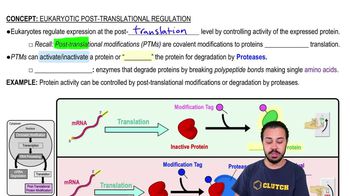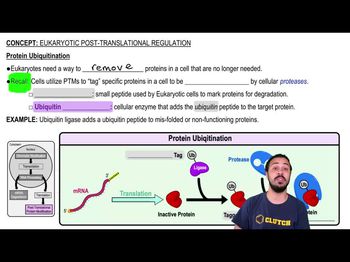Table of contents
- 1. Introduction to Biology2h 40m
- 2. Chemistry3h 40m
- 3. Water1h 26m
- 4. Biomolecules2h 23m
- 5. Cell Components2h 26m
- 6. The Membrane2h 31m
- 7. Energy and Metabolism2h 0m
- 8. Respiration2h 40m
- 9. Photosynthesis2h 49m
- 10. Cell Signaling59m
- 11. Cell Division2h 47m
- 12. Meiosis2h 0m
- 13. Mendelian Genetics4h 44m
- Introduction to Mendel's Experiments7m
- Genotype vs. Phenotype17m
- Punnett Squares13m
- Mendel's Experiments26m
- Mendel's Laws18m
- Monohybrid Crosses19m
- Test Crosses14m
- Dihybrid Crosses20m
- Punnett Square Probability26m
- Incomplete Dominance vs. Codominance20m
- Epistasis7m
- Non-Mendelian Genetics12m
- Pedigrees6m
- Autosomal Inheritance21m
- Sex-Linked Inheritance43m
- X-Inactivation9m
- 14. DNA Synthesis2h 27m
- 15. Gene Expression3h 20m
- 16. Regulation of Expression3h 31m
- Introduction to Regulation of Gene Expression13m
- Prokaryotic Gene Regulation via Operons27m
- The Lac Operon21m
- Glucose's Impact on Lac Operon25m
- The Trp Operon20m
- Review of the Lac Operon & Trp Operon11m
- Introduction to Eukaryotic Gene Regulation9m
- Eukaryotic Chromatin Modifications16m
- Eukaryotic Transcriptional Control22m
- Eukaryotic Post-Transcriptional Regulation28m
- Eukaryotic Post-Translational Regulation13m
- 17. Viruses37m
- 18. Biotechnology2h 58m
- 19. Genomics17m
- 20. Development1h 5m
- 21. Evolution3h 1m
- 22. Evolution of Populations3h 52m
- 23. Speciation1h 37m
- 24. History of Life on Earth2h 6m
- 25. Phylogeny2h 31m
- 26. Prokaryotes4h 59m
- 27. Protists1h 12m
- 28. Plants1h 22m
- 29. Fungi36m
- 30. Overview of Animals34m
- 31. Invertebrates1h 2m
- 32. Vertebrates50m
- 33. Plant Anatomy1h 3m
- 34. Vascular Plant Transport2m
- 35. Soil37m
- 36. Plant Reproduction47m
- 37. Plant Sensation and Response1h 9m
- 38. Animal Form and Function1h 19m
- 39. Digestive System10m
- 40. Circulatory System1h 57m
- 41. Immune System1h 12m
- 42. Osmoregulation and Excretion50m
- 43. Endocrine System4m
- 44. Animal Reproduction2m
- 45. Nervous System55m
- 46. Sensory Systems46m
- 47. Muscle Systems23m
- 48. Ecology3h 11m
- Introduction to Ecology20m
- Biogeography14m
- Earth's Climate Patterns50m
- Introduction to Terrestrial Biomes10m
- Terrestrial Biomes: Near Equator13m
- Terrestrial Biomes: Temperate Regions10m
- Terrestrial Biomes: Northern Regions15m
- Introduction to Aquatic Biomes27m
- Freshwater Aquatic Biomes14m
- Marine Aquatic Biomes13m
- 49. Animal Behavior28m
- 50. Population Ecology3h 41m
- Introduction to Population Ecology28m
- Population Sampling Methods23m
- Life History12m
- Population Demography17m
- Factors Limiting Population Growth14m
- Introduction to Population Growth Models22m
- Linear Population Growth6m
- Exponential Population Growth29m
- Logistic Population Growth32m
- r/K Selection10m
- The Human Population22m
- 51. Community Ecology2h 46m
- Introduction to Community Ecology2m
- Introduction to Community Interactions9m
- Community Interactions: Competition (-/-)38m
- Community Interactions: Exploitation (+/-)23m
- Community Interactions: Mutualism (+/+) & Commensalism (+/0)9m
- Community Structure35m
- Community Dynamics26m
- Geographic Impact on Communities21m
- 52. Ecosystems2h 36m
- 53. Conservation Biology24m
16. Regulation of Expression
Eukaryotic Post-Translational Regulation
Multiple Choice
A hormone signal reaches a cell and causes the cell to produce a large quantity of Protein X. After some time, the hormone signal disappears and the cell no longer needs a large quantity of Protein X. How will the cell remove the excess protein?
A
The repressor protein for the Protein X gene will stop the transcription of the gene.
B
The excess Protein X will be tagged with ubiquitin proteins and degraded over time.
C
The Protein X mRNA will be bound by a microRNA blocking its translation.
D
Over time the excess Protein X will diffuse out of the cell.
 Verified step by step guidance
Verified step by step guidance1
Understand the role of ubiquitin in protein degradation: Ubiquitin is a small protein that tags other proteins for degradation. When a protein is no longer needed, it is marked with ubiquitin molecules, signaling it for destruction by the proteasome, a complex that breaks down proteins.
Identify the process of ubiquitination: The cell uses enzymes called ubiquitin ligases to attach ubiquitin to the target protein. This process involves multiple steps where ubiquitin molecules are added sequentially to form a polyubiquitin chain.
Recognize the function of the proteasome: Once a protein is tagged with ubiquitin, it is recognized by the proteasome. The proteasome is a large protein complex that degrades and recycles proteins into amino acids, which can be reused by the cell.
Consider alternative mechanisms for reducing protein levels: Besides degradation, cells can regulate protein levels by controlling mRNA translation. MicroRNAs can bind to mRNA molecules, preventing their translation into proteins, thus reducing protein production.
Evaluate the diffusion of proteins: While diffusion is a passive process where molecules move from areas of high concentration to low concentration, it is not typically how cells manage excess proteins. Proteins are generally too large to diffuse freely across cell membranes without specific transport mechanisms.

 3:55m
3:55mWatch next
Master Eukaryotic Post-Translational Regulation with a bite sized video explanation from Jason Amores Sumpter
Start learningRelated Videos
Related Practice







